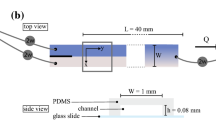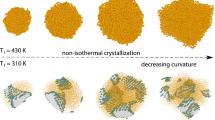Summary
Analyzing videomicroscopy observations, this work deals with macrovoids detected through the skin of asymmetric polymeric membranes. The circle-like images of the macrovoids were found to form two-dimensional random patterns ; these were characterized from the mean distance, <λ>, determined between nearest neighboring images. Starting from polyetherimide or polyacrylonitrile solutions, each solution cast as a film was immersed in a water bath, at room temperature ; <λ> was shortened either by increasing the solvent concentration in the casting solution or by decreasing the solvent concentration in the bath (non-solvent of the polymer). This study was based on the assumption that the formation of the macrovoid pattern may be correlated to the interface instability resulting from the current of solvent diffusing towards the bath and initiated by the immersion of the polymer solution. Master curves, involving <λ>, the solvent concentrations in the polymeric solutions or in the bath and the solvent diffusion coefficients, measured prior to the immersion of the solution in the bath, were drawn. Diffusion coefficients were measured using a pulsed magnetic field gradient method.
Similar content being viewed by others
Author information
Authors and Affiliations
Additional information
Received: 6 November 1998/Revised version: 9 February 1999/Accepted: 9 February 1999
Rights and permissions
About this article
Cite this article
Cohen Addad, J., Panine, P. Pore generation in asymmetric polymeric membranes Correlation with solvent mobilities. Polymer Bulletin 42, 345–352 (1999). https://doi.org/10.1007/s002890050473
Issue Date:
DOI: https://doi.org/10.1007/s002890050473




